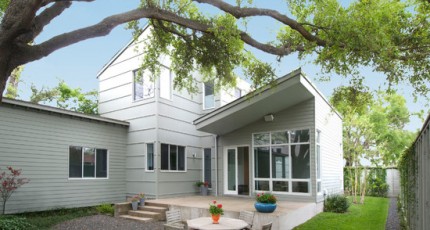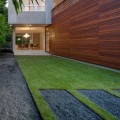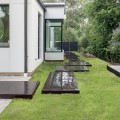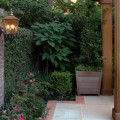Minimalist Garden Design

Minimalist garden design is not a specific style of gardening, but rather an aesthetic principle based upon the perspective that less is more. In these gardens, plants are carefully selected, and unusual materials are integrated into the vegetation. Hardscapes are used to define geometric shapes and linear movements that correspond to the architecture of the house and to other structures on the landscape.
In contemporary gardens, one will often find objects such as stainless steel and glass. These elements are deliberately placed in gardens to emphasize the dominion of humanity over nature. Or, you may find contemporary art in gardens where the home features a highly innovative design, and where the yards itself is something akin to an outdoor art gallery. Water elements in these environments are often used to offset the stark sense of contrast with a soothing or peaceful feeling, such as the kind one gets from a reflecting pool or disappearing fountain.
Minimalist garden design, in one form or fashion, has been around for centuries. Many cultures have taken a less-is-more approach to landscaping in order to express specific values and traditions in a clear manner that makes its point without overwhelming the senses. However, in recent times, minimalism has both exploded in popularity and shifted noticeably toward modern and contemporary garden design.
This is not to say that minimalist garden design will only work with contemporary or modern landscapes. As we have noted in other articles, minimalism in the West traces its roots back to Greek and Roman times. Both the Greeks and the Romans sought to strongly emphasize man’s control of nature in their landscaping works. As a result, traces of minimalism were handed down to every European garden design that followed the fall of Rome, including French Formal, Parterre, English, Italian, and Mediterranean. Minimalism is not a single style, remember, but rather an aesthetic approach to garden design. Any landscaping theme can benefit from minimalist garden design to some extent.
For one thing, it creates very low maintenance gardens that are perfect for the lifestyle of young professionals who have just moved into their own home. Because of their cautious use of softscape elements, minimalist gardens always have a clean appearance which adds interest and attractiveness to home entertainment venues. .
It also minimizes clutter and makes the yard feel more spacious. More areas of interest can be developed throughout the property, including swimming pools, outdoor kitchen architecture, sports recreation areas, and courtyards can all be greatly enhanced aesthetically gardens that work more to compliment geometry, landscape design them, and activity than it does to draw attention exclusively to itself.
However, people with a DIY mindset should be advised that minimalist garden design is best left in the hands of a professional landscape designer. Just because something is minimal does not mean it is easy. The term “less is more” is a literary oxymoron—i.e.: something that appears to make no sense at face value. Most people who try to tackle minimalism on their own wind up creating forms that either look boring, or too stark, because they overdo the “less” part of the equation.
What “less is more” really refers to is a careful balance of individual elements that is so controlled that no single element dominates the whole. In formal gardens, this demands expert knowledge of botanical science. In contemporary gardens, it requires mathematical precision and an awareness of how to use atypical elements and unique geometric patterns of hardscape to achieve a unified result.
This tightrope of design can only be walked by a landscape designer who can integrate minimalist garden design into all of the many other components of a landscape master plan. This master plan will work to create an outdoor living space that compliments home architecture and ties together all surrounding organic and inorganic landscape features.





